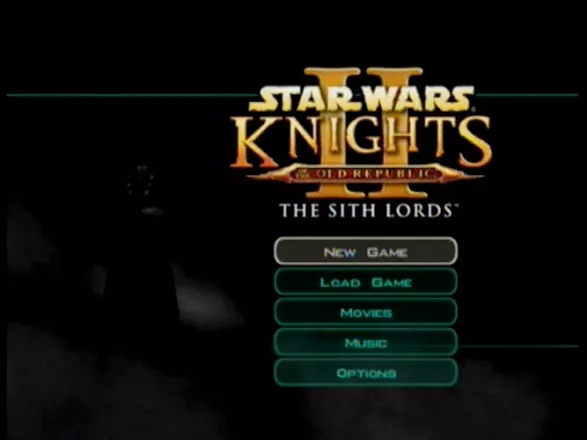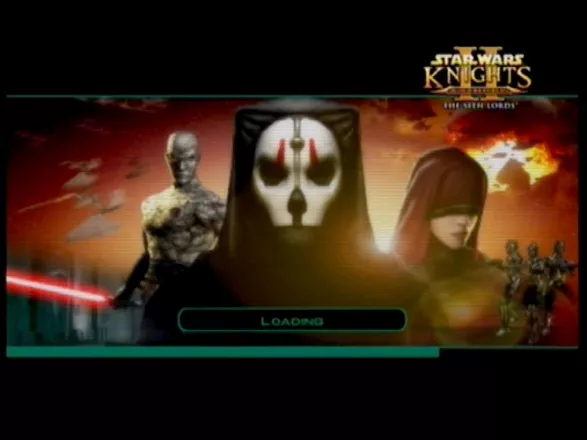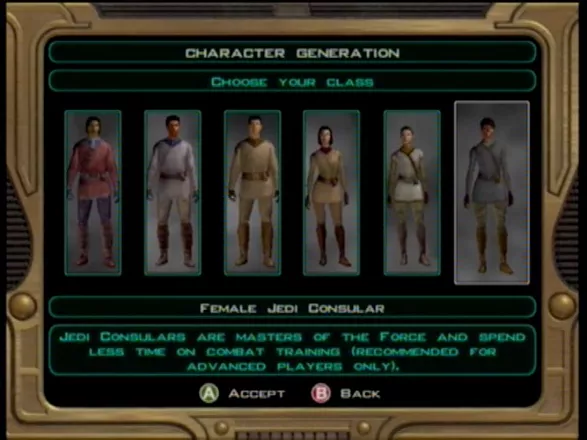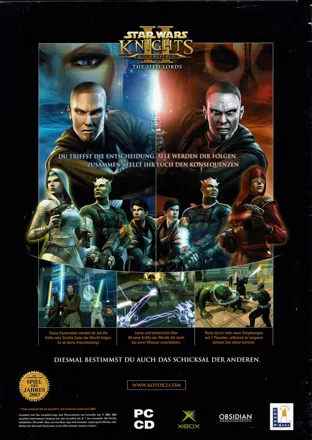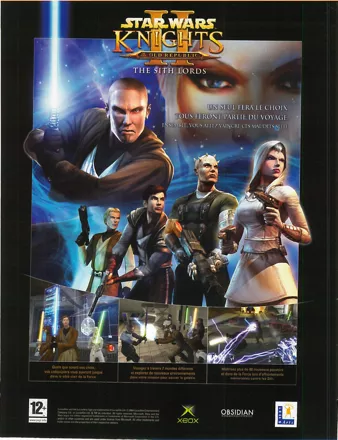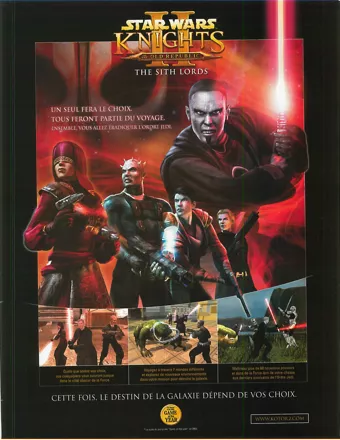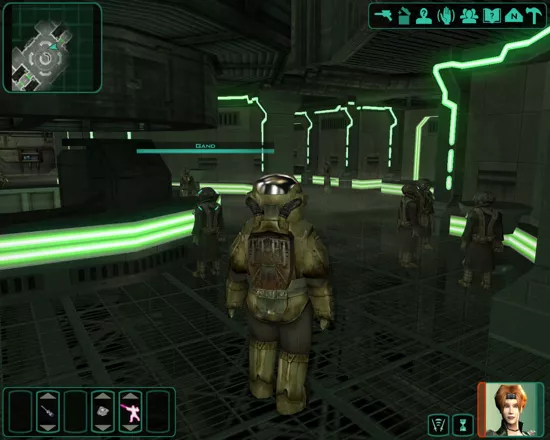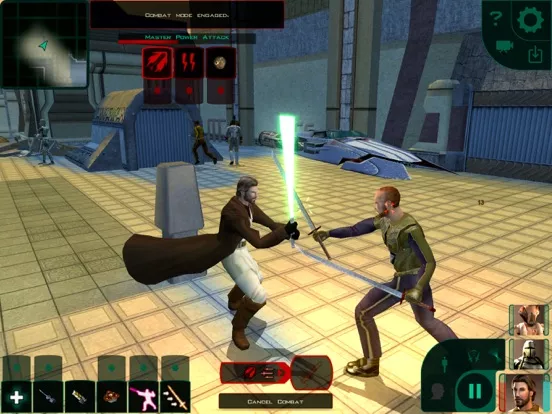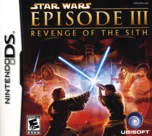Star Wars: Knights of the Old Republic II - The Sith Lords
Description official descriptions
Five years after the events depicted in Knights of the Old Republic, the Sith have become stronger and more determined to rule the Galaxy. The Jedi Order is nearly exterminated. A mysterious ex-Jedi has been exiled from the Order and is traveling alone. This Jedi had served under Darth Revan (when the latter was still on the Light side of the Force) during the Mandalorian Wars, but due to enigmatic circumstances was forced to retire. Now the past is catching up with the Jedi, and soon he or she will have to choose the side to fight on.
The Sith Lords looks and plays very similarly to its predecessor, also being based on the Star Wars d20 role-playing rule set (which, in its turn, is similar to the 3rd Edition of Dungeons & Dragons) and having the same combat engine, character development, and a Light and Dark ethical system, which judges the player's decisions and actions and influences story events and characters' responses. Additions to the gameplay include a lightsaber-crafting system, which allows augmenting lightsabers with various items, new Force powers, and the possibility to influence the alignments of the characters in the player-controlled party through conversation choices and other decisions. Most of the exploration and the combat sequences is done using a party of three, including the protagonist and two companions. However, certain parts of the game will force the player to travel alone, or to control a party made exclusively out of companions.
A large part of the military equipment can be upgraded using any workbench that can be found throughout the game world, including one available at all times on the ship that the player uses to travel between planetary systems. Different types of items have more than one piece that can be augmented. For example, the armor has two slots for upgrades (overlay and underlay), while ranged weapons have three (targeting, firing chamber, and power pack), and lightsabers have six. The easiest way to get additional upgrades is to either buy them or loot them, however they can be created as well at a workbench with the right components and enough repair skill. Medical items are a different sort and they can be crafted using lab stations.
At various moments during the game, the player has the opportunity to play some mini games: a card game called Pazaak, shooting targets using a turret from a first-person view, and swoop racing.
Spellings
- 旧共和国武士II:西斯领主 - Simplified Chinese spelling
Groups +
- 3D Engine: Odyssey
- Console Generation Exclusives: Xbox
- Force Powers-themed games
- Gameplay feature: Character development - Skill distribution
- Gameplay feature: Dating / Romance
- Gameplay feature: Gambling
- Gameplay feature: Multiple endings
- Middleware: FaceFX
- Protagonist: Female (option)
- Sound engine: AIL/Miles Sound System
- Star Wars licensees
- Star Wars: Knights of the Old Republic series
- Star Wars: The Old Republic games
- Symphonic Orchestra: Northwest Sinfonia
- Technology: amBX
- Xbox Platinum Hits releases
Screenshots
Promos
Videos
See any errors or missing info for this game?
You can submit a correction, contribute trivia, add to a game group, add a related site or alternate title.
Credits (Xbox version)
332 People (259 developers, 73 thanks) · View all
| CEO | |
| Executive Producer | |
| Producer | |
| Lead Designer | |
| Design Team | |
| Lead Artist | |
| Art Team | |
| Additional Concept Art | |
| [ full credits ] | |
Reviews
Critics
Average score: 83% (based on 59 ratings)
Players
Average score: 4.0 out of 5 (based on 140 ratings with 10 reviews)
A sequel with many improvements
The Good
This sequel may at first seem to be little different from the original. In fact, looking at the game graphically or based on gameplay, it is the same game but with a different story.
However, as you progress into the game, you notice many new features not found in the original. Although you could upgrade items with your workbench in the original, now you can also break items down and create your own items to use for upgrading weapons and armor. This can allow you to create much better equipment. There is also a lab station now, which lets you breakdown and create medpacks, stims, grenades, and mines. If you use these regularly, you won't have to worry about running out in the sequel. If you don't, then you'll be like me and never touch the lab station. Even so, it's a good addition.
Another useful thing in the game is that some of your party members will create items for you (security spikes, grenades, etc) and your T3 unit will let you upgrade items anywhere you want if it's in your party.
The number of upgrades available for your weapons and armor have been increased greatly, which lets you have a wider variety of choices. There are also many more weapon and armor types available in the game.
As with the previous game, communicating with your party members lets you gain various things. However, in this sequel, this is taken much farther. Talking to your party can gain them more abilities and powers (even create a dual-class jedi by taking on an apprentice). You can also improve your powers greatly by speaking to your party members... everything from increased force points to new force powers to ability to heal your T3 droid. It is strongly recommended that you talk to all your party members often.
Being a lightsaber user, I also am happy to see more color choices in the game. Unfortunately, some of the colors are not very different visually. Such as viridian being almost the same as green, and orange being almost the same as red. Still, more choice in color is great to see.
By taking the time to improve your light or dark side, you will get stat increases, such as +3 Wisdom. You can also get a nice stat increase by finding and using a lightsaber upgrade gem that's tuned to your own being... depending on if you're light or dark side and what class you are, you will gain some very powerful stat increases that get better as you level up.
I like how the game lets you learn about the original game with history and flashbacks. It's a good reminder of what happened in the original and can help people who have not played the original to better understand what led up to where this game is in history.
Dialogs are also interesting in this game. The programmers definitely had a sense of humor when coming up with the interactions between you and your party members and between themselves. All your droids tend to dislike each other and have various issues you'll end up seeing in cutscenes. Mira has some very interesting comments regarding you and your other female companions. Kreia just strives to get you to hate her and also has a very surprising comment regarding you and the handmaiden... which, in turn, gives you a dialog choice that is very funny to hear. The interactions start to bring you to the point seen in games like Planescape: Torment, where the characters really have a personality of their own and aren't just drones as found in most games.
Swoop racing has been improved to include changes in elevation, traffic, and mines. This can make it more challenging than the original races.
There are many lightsaber forms that affect not only how well you battle, but also change the movements you make while fighting. This makes the battles look much more interesting.
The Bad
The worst part of the game are the bugs. Watching the game crash frequently, having issues where swoop races that are completed seem to think you crashed and don't reward you, having party pathfinding poorly handled, having your character suddenly jump (not force jump, this is a bug) halfway across the screen ... often in the wrong direction... these make the game frustrating at times.
Although I understand not giving you a lightsaber at the start of the game, you don't end up getting one for a long time. Although the game is much longer than the original, the time to get your first lightsaber shouldn't be any longer than in the original. Most people, I think, prefer using a lightsaber in a Star Wars game and having to wait is annoying. There are also fewer drops for lightsabers. In the original, I ended up with over 20 red gems... in this one, I'm closer to 5. Granted, you don't need that many, but there just really aren't many colors to choose from for quite awhile into the game unless you start out at Dantooine.
There are many places where you must do everything when you're there, or you won't ever get the chance. Many places will not allow you to return to them after you leave. Although this can help with the plot, it can be annoying when you can't open something because of low skill and then you can't return with higher skill to open it.
As with the previous game, the plot is very fragmented. Each planet has its own story which supposedly all works together into one larger plot. However, there really isn't very much combining of the plots into one larger plot. About the only real thing combining the planets is the need to get all the Jedi Masters together. In most cases, if you complete everything on one planet, you never have to return. There's no comment about how you helped to restore a government or helped to get the fuel source for Telos...
The Bottom Line
If you liked the first game, you'll love this one. The new features really make the game an improvement over the first, even though the gameplay isn't changed. You definitely need to play the original first, as this game builds off the original a lot. If you're looking for cutting edge graphics, weren't a fan of the original game, or just don't like Star Wars, then this game isn't for you.
Windows · by Riamus (8480) · 2005
The Good
With a slightly different flavour from the original, Knights of the Old Republic II : The Sith Lords (k2 from now on) keeps just enough continuity with the original to be accessible, enjoyable, and at time extremely compelling. Because it is a sequel, it lacks the features that made KOTOR I a unique and superior to many RPG’s on the market, but while it doesn’t pave any new road, k2 provides an excellent gaming experience, even superior to its predecessor in many ways. This review will be written primarily for those who have not played the first KOTOR game.
As in all RPG’s, the fundamental questions of quality relate to storyline and character quality. Are the quests good? Are the characters memorable? Can I make meaningful alignment-related (e.g. good/evil) choices? Can I customise my character sufficiently to provide a ‘role-playing’ experience? Is the plot interesting? I would argue that in terms of these RPG/plot/character questions, k2 excels.
The plot starts out a bit confusingly, as you wake up on a station (in the age-old gaming plot device) without any recollection of how you got there. The confusing bit for the player, and a weakness of the story, is that somehow the CHARACTER seems to know a bit about his history, but you, the player know absolutely nothing. It’s quite odd to learn about your character by seeing him say ‘I used to be a Jedi.’ There are other hackneyed plot bits throughout, but it’s important to remember that this is an RPG, so the line between ‘hackneyed’ and ‘epic’ can become blurred.
These weaknesses aside, the plot is quite good. You’ll travel with your band of characters throughout the galaxy to different planets. You’ll then be embroiled in numerous minor and major quests that drive the ultimate story line about your main character.
The ‘boss’ bad guy is not revealed until quite late in the game, a la Neverwinter Nights. I’d argue that this is a strength to the game, as it makes the experience more compelling.
The characters throughout the game are fantastic. NPC’s abound, as well as the standard ‘commoner’ characters. ALL of the human conversations are voice-acted, and quite well I’d add. The NPC’s you interact with are usually memorable and lifelike. There are few ‘caricature’ characters in this game. Your character is a sort of anti-hero, another commonality between this and KOTOR I, but there’s a distinct subtlety to his anti-heroism. He has just enough mystery to be intriguing, but not enough to be clearly crafted as the ‘mysterious’ character. I think playing it through with a female character would be even more interesting, as anti-heroes are so rarely female. There is apparently the option to pursue romantic ties between your character and others, but I haven’t gotten around to it yet. Too busy force-choking people.
Additionally, ALL of the party members have distinct personalities, most of which are quite engaging. The meddling Kreia drives me up the wall, I chuckle at HK-47’s commentary, and also enjoy getting to know the somewhat-too-obviously-elusive Atton. It makes for satisfying gameplay to know that there are 8 or so people you can choose to have hang around your character. Like in the original, the party members you choose will interact with one another and you and you can learn more about their respective histories through fighting alongside them, much as you’d expect from real life, were you to be a space-faring adventurer…An additional element to this game that sets it apart from the original is that your main character will have ‘influence’ with each of the other characters. This influence is affected by whether or not you treat them well, agree with them, etc. The more influence you have, the more this character will ‘open’ up to yours in dialogue, and also the more their alignment will switch along with yours.
The quests contain the garden variety fetch quests. But in addition to the bread-and-butter quests you’d see in any RPG, there are a number of interesting minor quests available. Sometimes they involved playing two NPC’s off one another, sometimes there’s a betrayal involved, etc. Overall, the minor quests are good, if not great. Incidentally, a fair number of them involve puzzles which vary in difficulty, which might please the adventure-gamer within some players.
The major quests, which further the story line, are fantastic, and require their own paragraph. There is a great deal of party shuffling in this game (a la Final Fantasy 3 & &) but this is never a pain because all party members earn experience together (see gameplay comments below). Instead, it becomes really exciting to split the party up to see how other characters interact and get a chance to see how strong they’ve all become. I was riveted by all of the times in which your party gets split up. Usually, the cuts between groups are quite frequent and are tied to actual plot cliff-hangers with reasonable levels of importance (e.g. one of your characters appears to be dead). These are actually some of the best moments I’ve had in PC RPG gaming.
All in all, the RPG elements of k2 are fantastic, above and beyond the quality present in the first.
The gameplay is also excellent in its own right, even if it builds on its predecessor. It’s all a complex series of stats and dice rolls, a la D&D 3rd Edition. However, rather than simply having one motion for ‘attack,’ each melee move or blaster shot technique has a number of animations. The effect is that it appears to be real-time fighting even though it’s actually a series of rolls. Clever. One will eventually see all there is to see in the combat system, but this is to be expected and is hardly much of a weakness.
There are feats, skills, attributes, and force powers to contend with for each character. Obviously, non-force users don’t get force powers. The number of feats has been increased since KOTOR I, which I feel is a positive thing. KOTOR I felt like dumbed-down D&D 3rd Ed (no comment) and k2 has done much to increase the complexity of choices available to players. Still, much remains the same. There are two basic paths to combat: ranged and melee, and within each are three feats to use for attacking. There are also 8 or so skills (computer, repair, etc) which are identical to KOTOR I. Suffice it to say that there is a reasonable amount of customisation available, but not as much as in a proper RPG. But this is also expectable. Think of k2 as Neverwinter Nights with training wheels.
Actual in-game control is fluid and intuitive. There is a optional training scene at the beginning of the game to assist in orientation to the control of the game, but many won’t need it.
The Bad
The graphics and sound are beginning to look and sound their age. With the source engine, far cry, doom3, and all manner of other great graphical engines, k2 is dated. Full stop. The sounds are also mostly recycled from a) John Williams’ now 25-year-old score or b) the same as in KOTOR I. The dated quality of the graphics and the samey-ness of the sounds are clear weaknesses to the game. Still, because this is an RPG and not a FPS, I’d argue that they are minor weaknesses.
The Bottom Line
To summarise, KOTOR II is a fantastic game. It is simple compared to other RPG’s out there, but it is also accessible, engaging, and entertaining. It has an excellent plot, memorable characters, and a reasonable amount of room for character customisation. While its graphics and sound are a bit drab, these weaknesses are not significant when compared to the strengths, as this game contains some incredible gaming moments. And hey, who DOESN’T want to be a Jedi for a little while?
Windows · by Marty Bonus (39) · 2005
Impending classic beset by major hindrances
The Good
The year 2003 was a year wrought with lameness for the gaming world. Many may disagree, but I found nary a game that year piqued any splinter of interest. Thankfully, Lucas Arts gave us Knights of the Old Republic, probably the best release of that year, let alone the best RPG. It boasted the literally malleable and ever-popular Star Wars universe, BioWare’s design skills, and more than anything, and an engaging story that crushes anything George Lucas has mustered in recent times. In 2004, developer Obsidian attempted to continue that greatness with Knights of the Old Republic II: The Sith Lords.
In the grand scheme of things, it is very similar mechanically to its predecessor. The graphics engine, the conversation system, combat, travel, menus, and character system remain virtually unchanged, so players shouldn’t expect any disconcerting overhauls with these aspects. However, some very convenient modifications have been made in some of said aspects to make playing a bit less frustrating than in the original. Firstly, the combat system has been tweaked to allow control of the party’s behavioral stance; character units can be commanded to be aggressive, stand ground, or be ranged. The big plus of this is that when an enemy is sighted, your party won’t run in all guns blazing toward the enemy, something that grew very annoying when you were attempting to be stealthy, or simply weren’t prepared to attack. The “Ranged” stance is particularly useful if certain characters aren’t specialized in melee combat (such as characters with blasters or Jedi Consular). Secondly, the menus have been tweaked for convenience as well, mainly by categorizing items under separate titles, so that one isn’t scrolling all up and down trying to locate a particular item [I found this to especially be a problem with data pads]. Third, the character system has been updated to include a slough of new Feats and Force Powers which, of course, add some more fun to combat, but I won’t list them here. Another nifty (but inconsistent) feature is the ability to influence the alignment of your party members during conversation.
Unfortunately, these are about the only good aspects I can congregate for this review. While the aforementioned improvements are welcomed and cause the gameplay to be more manageable, well…shift your eyes below.
The Bad
While the prequel began with an anxious and semi-intriguing, yet short preliminary mission, KOTOR II begins with an optional (and tedious) introductory mission with T3-M4 aboard the torn asunder shell of the Ebon Hawk, with nothing but two unconscious bodies for company. Playing as T3-M4, you roll around the ship making what repairs you can to get the Hawk space worthy again; aka, “A Day in the Life of an Astromech Droid”. Though this mission provides some quaint fun on first-time play, I can’t see myself wanting to play each time I install the game. After skipping or playing through the introduction, your character wakes up in a kolto tank (I guess bacta had yet to be discovered) on a fuel mining asteroid station, wherein the game officially begins. If there were a better metaphor for the game’s overall design and player experience, I’m not a skilled enough writer to think of such.
The design of the game is noticeably inferior to BioWare’s. While the handy yet comparably diminutive mechanical improvements are a good thing, they are a galaxy away from maintaining the quality of the prequel. With the exception of the first character to join your party (and one certain sarcastic and bloodthirsty yet loveable character from KOTOR), the rest of the characters lack any kind of peculiar and/or charming charisma to inspire the player. The characters in the original game were a group of widely varying beings from completely different backgrounds, different alignments, skills and areas of expertise, but each one brought their own useful and appealing element to the game, like any good RPG should possess (or like the Star Wars films). I could barely wait to take each party member with me on different planets/missions and experiment to see what results I would get, or to converse with each one to find out more about their personality and personal history. Instead, you’re given a party of humdrum; boring characters that don’t motivate you to do any of the latter…in fact I would have been ecstatic to dismember most of them with a lightsaber. The game is also riddled with strange and game-stopping bugs (usually contained within conversation triggers) that even the patch failed to repair. The only path around these bugs is to either reload a saved game, or even such seemingly trivial actions as entering a room from a different door where a conversation will take place (?!). With a few notable exceptions (most all of which involve hijinks on the smuggler planet of Nar Shaada), the planets/missions themselves are exercises in pure tedium. Rather than wanting to carry out various trial and error experiments during the missions, I just wanted them to…end.
The plot of the game was truly an unwieldy, shoddy story to be behold. Admittedly, it is in fact difficult to depict the faults without giving away said “plot” (I use that term loosely), something I never take delight in doing, even if I happen to find it to be less than desirable in many facets. I would that guess that it could be compared to the following scenario: if the overrated hack of a director named M. Night Shamaylan was given the opportunity to write and direct a Star Wars film, it would more than likely end up very much like the plot of this game. Much like every other aspect of the game, instead of sitting in front of my monitor with great anticipation of what would unfold, I just wanted it to…end.
The Bottom Line
What we have here is a paradigm example of rushing the development of a game to hit stores shelves in time for the holiday season, something publishers never seem to learn. Not to mention the more detrimental dangers of changing developers in the middle of a series. As another reviewer said, this game has the feel of a buggy, glorified expansion pack, rather than a legitimate sequel in its own right. And in my own opinion, I fail to see how anyone could view this as an “improvement” over the first game. At the very least, it’s the game development equivalent of delivering the script of a notable and reliable director into the hands of college drunk and letting them overhaul said script for their own devices.
This game is worth owning for completist purposes, but I can’t see any other reason for purchasing this tedious, bug-ridden refuse with plot holes the size of the Betelgeuse.
Windows · by HandofShadow (49) · 2006
Discussion
| Subject | By | Date |
|---|---|---|
| Re: @#$^$%@#$^!!!!!!!!!!!!!!!! | Zovni (10504) | Jan 3, 2011 |
| OpenGl Drivers hell.. | Scott Monster (986) | Apr 25, 2009 |
| @#$^$%@#$^!!!!!!!!!!!!!!!! | Scott Monster (986) | Apr 20, 2008 |
Trivia
1001 Video Games
Star Wars: Knights of the Old Republic II appears in the book 1001 Video Games You Must Play Before You Die by General Editor Tony Mott.
Cut content
KOTOR2 was originally intended to have a longer more well developed ending involving the rest of your party members. However this was cut out and it is rumoured that Obsidian Entertainment was pressured to finish the game in time for the holiday season by Lucasarts. They were only given a 12 month development timeline.
A part of the cut material was an entire planet inhabited by droids. Unfortunately, the entire planet was cut from the game due to time constraints, making several of HK-47's subquests impossible to complete and leaving a crucial subplot unresolved.
The influence system that was introduced to the KOTOR series in this game was originally going effect the game far more than it did in the final version. Like the HK factory and other things the time constraints forced Obsidian to scrapped most of the consequences of influencing certain characters to the Light or Dark Side. An example is that in the original version if you influenced Atton to the Dark Side he would KILL the Disciple, and if you influenced him to the Light Side he would sacrifice himself to save the Exile and the rest of the Ebon Hawk crew. In the end, because of lack of time, the influence feature did little more than change the characters appearance (if the went to Dark Side) and gave them a little more attitude.
Cut content restoration
Because Obsidian was not allowed to work on the game post-release, fans worked on mods to restore the content. The effort by the modding group Team Gizka failed, but the unrelated project "The Sith Lords Restoration Project" was eventually released in 2009. As of 2012 it reached version 1.7 and is still in further development.
Game start
The events of the original game are relayed from the player to another character, giving the player the option to base the sequel on either ending (and the protagonist's gender) the original game offered.
References
- At the end of the game when the exile asks Kreia about the future she says something along the lines of "The Mandalorians die out over the course of millenia, until the only relic left of them will be a bounty hunter clad in their armor, killed all too easily by a Jedi. She is referring to Boba or Jango Fett (or both) from the Star Wars movies.
- If you ask Kreia about what will happen to the Republic in the future, she will claim that the republic will fall over the course of 1000 years. This is referring to Star Wars: Episode III where, 1000 years after KOTOR 2 according to Star Wars continuity, Emperor Palpatine destroys the Republic and reforms it as the Galactic Empire.
Awards
- GameSpy
- 2004 – #5 Xbox Game of the Year
- 2004 – Xbox RPG of the Year
- 2005 – Best Character of the Year (PC) (for Kreia)
- PC Powerplay (Germany)
- Issue 02/2006 - #3 RPG/Adventure in 2005
- Issue 04/2006 - #4 RPG/Adventure in 2005 (Readers' Vote)
Information also contributed by Rambutaan and Zack Green.
Analytics
Upgrade to MobyPro to view research rankings!
Related Sites +
-
Developer Interview
Xecuted staff discusses The Sith Lords with Mike Gallo, the game's producer. (Jan. 30, 2005) -
Let's Play Knights of the Old Republic II
A "Let's Play" of the game on lparchive.org (English) -
LucasArts KOTOR II Website
Official Sith Lords website, featuring details, boards and downloads. -
Old-Republic.com
Fansite containing various information about the series. -
Sith Lords Hints
The Universal Hint System guide provides the solution and strategies in question and answer format. -
StarWarsKnights.com
English fansite containing news, strategy guides, downloads and more (complete series covered). -
Sternenschmiede
German fansite containing news, walkthroughs, downloads and more (complete series covered). -
The Sith Lords Restored Content Mod
A modification which attempts to restore the cut content of the game (moddb.com)
Identifiers +
Contribute
Are you familiar with this game? Help document and preserve this entry in video game history! If your contribution is approved, you will earn points and be credited as a contributor.
Contributors to this Entry
Game added by Kartanym.
Nintendo Switch added by Plok. Xbox One added by Kennyannydenny. iPhone, Android, iPad, Linux, Macintosh added by Sciere.
Additional contributors: Rebound Boy, Unicorn Lynx, Jeanne, tarmo888, MegaMegaMan, Cantillon, Patrick Bregger, FatherJack.
Game added December 7, 2004. Last modified February 16, 2024.


